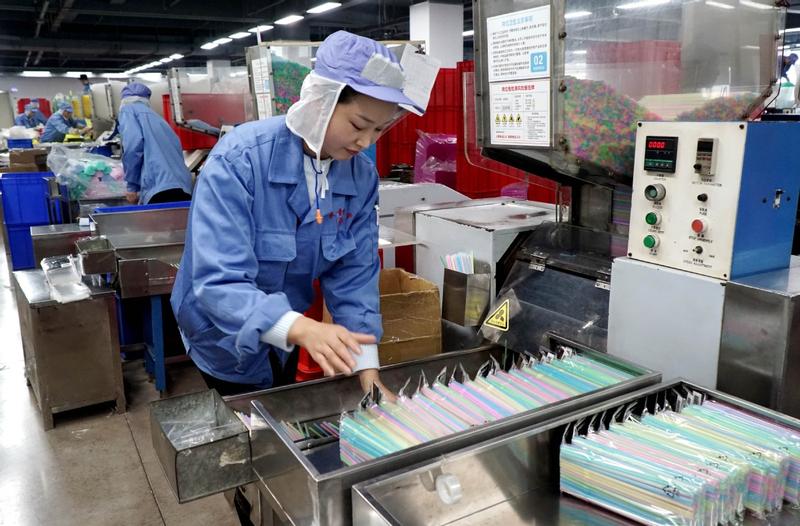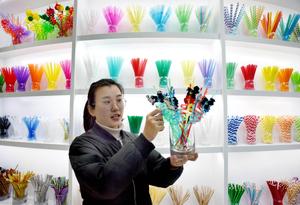 Employees make edible straws from starch at a factory in Yiwu, Zhejiang province, in December 2020. (ZHANG JIANCHENG / FOR CHINA DAILY)
Employees make edible straws from starch at a factory in Yiwu, Zhejiang province, in December 2020. (ZHANG JIANCHENG / FOR CHINA DAILY)
For bubble tea buff Ding Yi, it's the third time this week that his drink tasted like wet cardboard, with the culprit being a paper straw.
"My milk tea tasted awful, and the paper straws got soft and partly dissolved after a period of time in the drink, which made it hard to suck up the chewy tapioca balls. I'm considering switching to bubble tea stores that offer polylactic acid straws, which I heard have less impact on taste compared with paper equivalents," Ding said.
PLA is a form of biodegradable plastic that is produced from renewable resources. The material can be decomposed into carbon dioxide and water and produced from plant-based feedstock such as corn.
Since China upgraded its plastic restrictions last year, non-degradable single-use plastic straws have begun to be phased out of the catering industry starting from late 2020, and environmentally friendly straws are having their new moment in the sun. Experts said paper straws, PLA alternatives and other similarly themed products are creating billion-dollar businesses, despite the jury still being out on their impact on the taste of the beverages.
"Although we only use plastic straws for a few moments, it can take hundreds of years for them to decompose. Most plastic straws are single-use as recycling is very problematic due to technological limitations and prohibitive costs," said Lin Boqiang, head of the China Institute for Studies in Energy Policy at Xiamen University.
ALSO READ: Locals act against plastic waste in Tibet
"Most plastic straws in China are buried in landfills as other means of disposal are much more costly or lack technical support. However, plastics decompose extremely slowly in soil. When dumping plastics into landfills, they usually decompose into nano-sized plastic particles. These particles are often consumed by wildlife and eventually enter into humans, causing great harm to health, the ecosystem as well as the environment," Lin said.
Developing biodegradable plastic products and innovating technologies to improve productivity and reduce costs are becoming the new trend in the plastics industry and will open the door for numerous business opportunities.
Wan Lei, deputy head of the technology department at the China Chemical Fibers Association
China's consumption of plastic straws is huge, according to a report by China Central Television. The report said the cumulative output of plastic straws was about 30,000 metric tons in 2019, and the average annual plastic straw use per capita stood at over 30 units.
As non-biodegradable single-use plastic straws have been virtually removed from the catering industry due to environmental concerns, paper, PLA and steel alternatives are seeing increasing orders in China.
Among numerous choices, paper straws topped the list for many beverage companies in China. According to a report by Huaan Securities Co Ltd, the market size of paper straws is likely to reach up to 28 billion yuan (US$4.33 billion) in 2025.
Wu Mengyong, a worker at a Guangzhou-based paper straw company, told news media 36kr that the factory has been in full production mode since the end of last year.
ALSO READ: Hainan leads in banning non-biodegradable plastic
"Most of our clients want paper straws. We are not worried about the market but are concerned about how to raise productivity to meet market demand," Wu said. His workplace can produce about 300,000-400,000 units per day, and hopes to eventually have monthly production of over 30 million.
"Paper straws are generally less harmful to the environment as they are biodegradable and take much less time to decompose," Lin said.
 An employee showcases biodegradable straws decorated with the Year of the Ox figures at an exhibition hall in Yiwu in December 2020. (ZHANG JIANCHENG / FOR CHINA DAILY)
An employee showcases biodegradable straws decorated with the Year of the Ox figures at an exhibition hall in Yiwu in December 2020. (ZHANG JIANCHENG / FOR CHINA DAILY)
No matter how environmentally friendly paper straws are, they are having a difficult time being accepted by consumers. The topic "paper straws influence taste of bubble tea" even made top-ranked hot searches on social media platforms several times last month. Related posts on Weibo have exceeded 40,000 with over 770 million views to date. Complaints include having a papery taste, not being hard enough to pierce through drink lids and too easy to soften and dissolve in beverages.
"Paper straws also have an impact on the environment. On one hand, they consume a large amount of trees, and on the other hand, they also cause pollution during production. More efforts are needed for the research and development of other alternatives," Lin added.
As complaints concerning paper straws became trending topics, many netizens began sharing reviews of alternative straws, with biodegradable plastics like PLA straws, collapsible metal straws and various others topping the list.
The market of alternatives to plastic products is just starting in China, with the focus on developing new counterparts that are not harmful to the environment and customer-friendly without costing a lot of money. It is a trend that China will phase out environmentally unfriendly plastic products in the near future.
Lin Boqiang, head of the China Institute for Studies in Energy Policy at Xiamen University
"Developing biodegradable plastic products and innovating technologies to improve productivity and reduce costs are becoming the new trend in the plastics industry and will open the door for numerous business opportunities," Wan Lei, deputy head of the technology department at the China Chemical Fibers Association, told Shanxi Evening News.
According to a report by Huaan Securities Co Ltd, the market size of decomposable plastics in China will reach 47.7 billion yuan by 2025.
Chen Yi, general manager of Nanjing Wurui Biodegradable New Material Research Institute Co Ltd, told Xinhua News Agency that PLA straws outperformed other alternatives to non-degradable plastic counterparts in retaining the flavor of drinks.
"Last year witnessed a steep rise in PLA straw prices, from 18,000 yuan to 30,000 yuan per ton, and it is still riding high," Chen told Xinhua.
Chinese tea drink shop chains, including Heytea, Coco, and Nayuki, have also started using PLA straws to serve customers.
Huang Xinyi, a 30-year-old white collar worker in Beijing, said she prefers buying drinks, especially bubble teas, from brands that offer PLA straws. "It tastes much better than paper straws. Paper straws have a papery or cardboard-like flavor and cannot be soaked into drinks for a long time. That said, I need to finish the drinks soon after I open them. But such situations do not happen with PLA straws."
According to a report by Beijing Youth Daily, despite PLA straws offering better taste for consumers, a majority of caterers still choose paper straws, as the cost of the former is about 60 percent higher than the latter.
 In this undated file photo, a Starbucks drink with a paper straw is provided to a customer at a store in Zhengzhou, Henan province. (PHOTO PROVIDED TO CHINA DAILY)
In this undated file photo, a Starbucks drink with a paper straw is provided to a customer at a store in Zhengzhou, Henan province. (PHOTO PROVIDED TO CHINA DAILY)
Some other brands, including McDonald's China branches, came up with the solution of lids from which consumers can drink directly. Over 90 percent of KFC outlets also removed plastic cutlery in both dine-in and delivery services, and promoting the use of wooden spoons.
Another popular alternative is collapsible metal straws that are also reusable. They can be as long as 23 centimeters when stretched out full, and can also be as short as 10 centimeters. This makes them convenient for consumers to take wherever they go. The collapsible metal straws are sold packaged in small boxes which makes them more portable.
"The market of alternatives to plastic products is just starting in China, with the focus on developing new counterparts that are not harmful to the environment and customer-friendly without costing a lot of money. It is a trend that China will phase out environmentally unfriendly plastic products in the near future," Lin said.
China has been in a battle against plastic waste for a long time. Back in 2008, the government imposed limits on the use of plastic bags. Starting from that time, supermarkets and grocery stores have been prohibited from giving out free plastic bags to customers.
Plastic bags were also mentioned in last year's plastic restrictions. Aside from banning single-use plastic straws, restrictions rolled out last year also banned the production and sale of a slew of other plastic products including ultrathin plastic shopping bags with a thickness of less than 0.025 millimeter and plastics containing medical waste.
Plastic bags are another focus of attention in battling plastic waste. According to data from the China Plastic Processing Industry Association, the average annual use of plastic bags surpassed 4 million tons as of 2019, and China was seeing a surging number of plastics used in food delivery services and logistics. The average annual consumption of plastics for logistics reached about 1.8 million tons, while that of food delivery was about 500,000 tons.
Last year's restrictions also put a limit on the use of products, including non-disposable plastic bags and packages in general and single-use plastic utensils.
READ MORE: China unveils measures for green growth in 2021
The restrictions were part of the Chinese government's stepped-up efforts to control plastic pollution. The goal is to set up a management system for the production, circulation, consumption, recycling and disposal of plastic products, beef up development of sustainable alternatives to plastics, reduce the amount of plastic garbage in landfills and effectively control plastic pollution by 2025.


